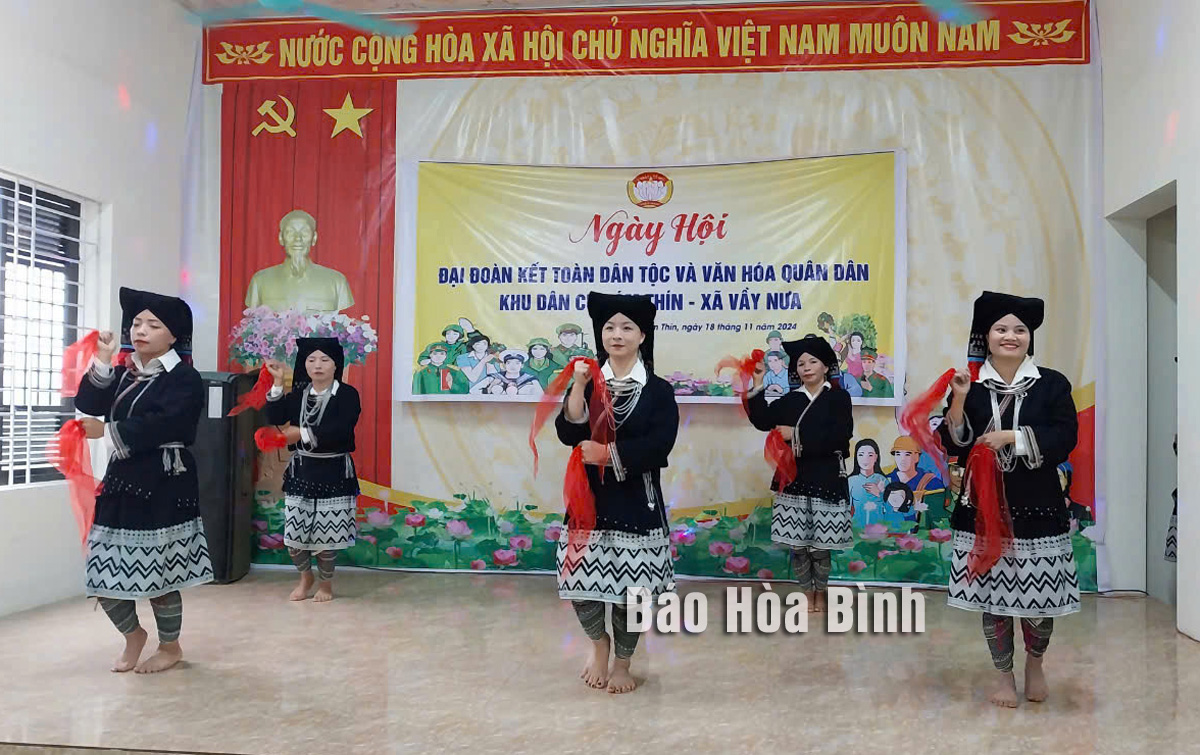
Great National Unity Day has been recently celebrated in Duong hamlet, Vay Nua commune, Da Bac district, in an atmosphere of warmth and community spirit. The event highlighted national identity and strengthened the bond of solidarity among residents.
A
performance of Tay ethnic people in Thin hamlet, Vay Nua commune, Da Bac
district at Great National Unity Day.
Located at the centre of Vay Nua commune, Duong hamlet is home to 81 households
with 325 residents. The Dao ethnic group makes up 98% of the population, while
the remainder consists of Muong and Tay people. This year, the hamlet
demonstrated strong solidarity by actively participating in movements and
campaigns, particularly the "All people stay united to build new-style rural
areas and civilised urban areas.” These efforts have bolstered community
cohesion and contributed significantly to the commune’s progress in new-style
rural development.
Throughout November, other hamlets in Vay Nua commune also held
celebrations to mark Great National Unity Day and the Military-Civilian
Cultural Day. According to Dinh Thanh Phu, Secretary of the Commune's Party
Committee, these events not only reflect community solidarity and sound
cultural values but also enrich the cultural life of the region. This unity
serves as a source of strength, enabling ethnic groups to live in harmony,
support one another, and overcome challenges in the journey toward building
new-style rural areas.
Vay Nua commune, situated along the Da River about 20km from the
district center, comprises eight hamlets predominantly inhabited by the Dao and
Muong ethnic groups. The commune faces significant challenges, including uneven
population distribution, underdeveloped infrastructure, and economic hardship.
Currently, 28.57% of households are classified as poor, while 26.2% are
near-poor.
Despite these difficulties, the solidarity among the Party organisation, local
authorities, and residents has been key to ensuring political stability, social
and security order, and economic progress. Residents trust the leadership of
the Party and actively participate in campaigns to build new-style rural areas
and foster a vibrant cultural life.
Da Bac district, where ethnic minorities make up 89.72% of the population, is
home to five ethnic groups living harmoniously while preserving their unique
cultural traditions. This diversity creates a rich and dynamic cultural and
spiritual life in the region.
As of November 20, all residential areas in Da Bac district had successfully
organised Great National Unity Day. Dinh Thi Kieu, Chairwoman of the Vietnam
Fatherland Front (VFF)’s chapter in Da Bac district, noted that these
celebrations were held safely, economically, and effectively. They honoured
traditional cultural values, recognised outstanding individuals and exemplary
families, and fostered unity between military personnel, officials, and
residents, thereby strengthening spiritual foundation in the new cultural
life.
The clothing of women reflects the culture of the Muong, Thai, Tay, Dao, and Mong ethnic groups in the northern province of Hoa Binh.
Gongs hold a special place in the cultural and spiritual life of the Muong ethnic people in Hoa Binh province. More than musical instruments, they are an indispensable part of community rituals and collective memory, echoing through generations as a spiritual thread linking the past, present, and future.
Preserving and promoting the cultural values of the Muong ethnic group has become an urgent task in the current context, as many traditional values face the risk of fading away. This effort requires not only protecting the cultural identity but also eliminating outdated customs and developing a modern cultural lifestyle, contributing to sustainable values for the Muong community in Hoa Binh province.
The Muong ethnic culture, deeply rooted in Vietnam’s mountainous north, continues to be preserved and revitalised by dedicated individuals and communities determined to safeguard their ancestral identity.
The Muong group is one of the largest ethnic minorities in Vietnam, primarily found in Hoa Binh province. The Muong people in Hoa Binh boast a rich and diverse cultural treasure that reflects the unique identity of this ethnic group. Accounting for over 63% of the province's population, they have created and preserved numerous distinctive cultural values, contributing to their unique identity. Their cultural heritage is an invaluable asset, at the heart of their national identity, and represents a vibrant spiritual life that must be preserved and promoted in today’s modern world.
For generations, the ethnic communities of Hoa Binh province, particularly the Muong people, have preserved vibrant festivals deeply intertwined with the region’s geography, nature, and social traditions. These celebrations enrich Hoa Binh’s spiritual life and cultural identity, reflecting both folk beliefs and the intermingling of ethnic customs. Many of these festivals have endured the test of time, passed down through generations and continuing to thrive today. Among them, the Khai Ha (Going Down to the Field) festival stands out as one of the most significant events of the Muong ethnic group.



